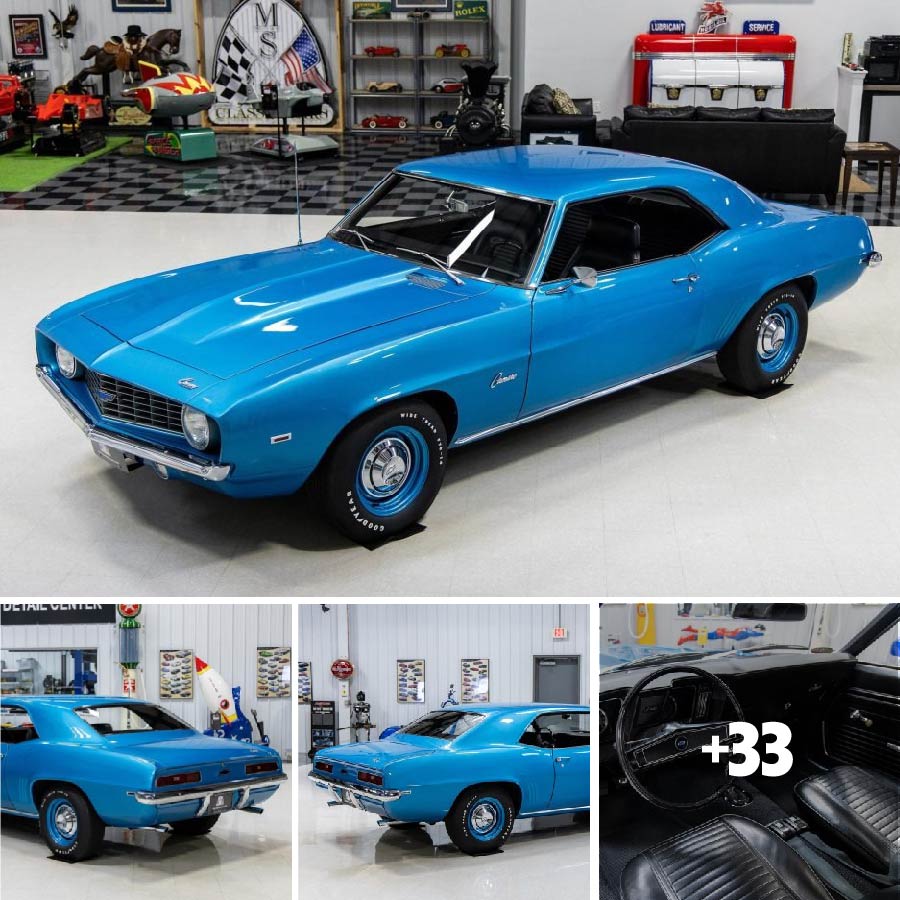
In the annals of automotive lore, the 1969 Chevrolet Camaro coupe stands as a paragon of American muscle, first gracing the showroom floor of Ray Bryant Chevrolet Company in Dayton, Ohio. This particular specimen is an elusive gem, one of fewer than a thousand manufactured with the COPO 427ci L72 V8 engine for that model year. Known as “Rat’s Nest,” this powerhouse reigned supreme in NHRA Super Stock SS/D competitions throughout the 1970s.
A meticulous rotisserie restoration, initiated in 2018 and culminating just in time for a grand display at the 2021 Camaro Nationals in July, saw the car resplendently repainted in LeMans Blue, with an interior lavishly outfitted in black vinyl. The heart of this beast, a replacement #512-block 427ci V8, is mated to a new Muncie M22 four-speed transmission, linked to a robust 12-bolt rear axle fortified with a Positraction differential.
Enhancing its formidable setup, the Camaro boasts a Hurst shifter, potent power front disc brakes, 14″ XT steel wheels, a Gardner dual exhaust system, a high-performance Holley carburetor, a Winters high-rise intake manifold, and a functional ducted hood. Acquired by the current dealer in April 2024, the car underwent further refinements, including transmission front shaft resealing, coolant system flushing, carburetor tuning, valve adjustments, and the replacement of pushrods, rocker arms, rocker studs, poly locks, spark plugs, wires, and thermostat.

Offered now in Massachusetts, this COPO Camaro comes with an array of documentation including two Jerry MacNeish reports and Certificates of Authenticity, an NCRS shipping data report, a comprehensive history from previous owners, interview notes, an owner’s manual, touch-up paint, uninstalled chrome bumpers, show results and awards, a hardcover book detailing the refurbishment, magazine appearances, and a clean Ohio title.

Photographic evidence reveals the car’s vibrant past, decked in a blue, white, and red livery, bearing the “Rat’s Nest” moniker from the early to mid-1970s. Modifications from the late 1970s include the replacement of the front fenders, trunk lid, and windshield.

The exterior is graced with a ZL2 cowl-induction hood, a fresh coat of LeMans Blue (71), and assembly markings replicated with precision on the inner panels, firewall, and subframe. Chrome bumpers, bright rocker-panel trim, and a driver-side mirror add to its allure.

The Camaro rides on body-color 14″ XT-code steel wheels adorned with branded chrome hubcaps and Goodyear Wide Tread F70-14 white-letter tires, with a reproduction spare in the trunk. Factory features include power-assisted front disc brakes and rear drums.

Inside, the cabin showcases standard black vinyl upholstery with front bucket and rear bench seats. The MacNeish report confirms the installation of a matching replacement headliner and carpeting. Additional interior features include a floor-mounted Hurst shifter, a push-button Delco AM radio, a heater/defroster, and lap belts. The two-spoke steering wheel fronts a 120-mph speedometer and a fuel-level gauge, with the five-digit odometer recording 16k miles.

Under the hood, the rebuilt 427ci L72 V8, factory rated at 425 horsepower, epitomizes the power available through the 1969 Camaro’s COPO program. It features a high-lift camshaft, solid valve lifters, a Holley four-barrel carburetor, a Winters aluminum high-rise intake manifold, and a Gardner reproduction dual exhaust system. The #512 engine block, as noted in the MacNeish report, is a correctly dated replacement.

Completing the drivetrain, the Muncie M22 four-speed manual transmission connects to a BE-coded 12-bolt rear axle with a Positraction differential and a 4.10:1 final gear ratio, with the transmission itself identified as a replacement unit by the MacNeish report.
This restored and meticulously documented COPO Camaro represents an extraordinary piece of automotive history, seamlessly blending heritage and performance.
